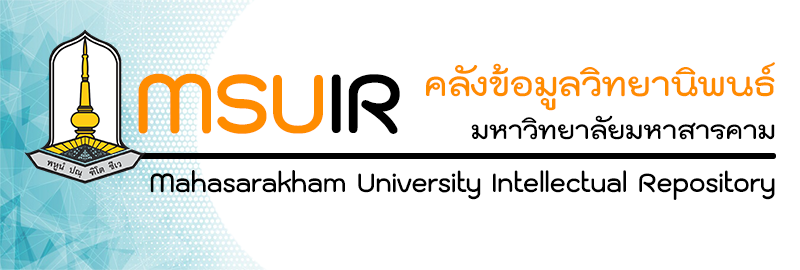Please use this identifier to cite or link to this item:
http://202.28.34.124/dspace/handle123456789/2680| Title: | Slow Pyrolysis of Waste Chicken and Duck Bone for Production of Biochar and its Use for Removal of Heavy Metal in Acidic Solution การกำจัดทองแดงในสารละลายกรดด้วยถ่านชาร์จากกระดูกไก่และเป็ดที่เตรียมด้วยกระบวนการแยกสลายด้วยความร้อนแบบช้า |
| Authors: | Pattaranun Maskhunthod ภัทรนันต์ มาศขุนทด Surachai Wongcharee สุรชัย วงชารี Mahasarakham University Surachai Wongcharee สุรชัย วงชารี surachai.w@gmail.com surachai.w@gmail.com |
| Keywords: | กระดูกไก่ กระดูกเป็ด ถ่านชาร์ ทองแดง Chicken bones Duck bones Biochar Copper |
| Issue Date: | 21 |
| Publisher: | Mahasarakham University |
| Abstract: | This research investigates the preparation of biochar from chicken and duck bones discarded by restaurants in Maha Sarakham province through slow pyrolysis at temperatures of 300, 400, and 500 degrees Celsius. The objective is to evaluate their efficacy in adsorbing copper from acidic solutions and to characterize the physical and chemical properties of the resulting biochar. The study found that the post-pyrolysis bone char exhibits a glossy black appearance with a high carbon content. Specifically, duck bone char produced at 500 degrees Celsius showed the highest specific surface area of 84.18 square meters per gram, with pore diameters ranging from 6 to 12 nanometers, classifying it as mesoporous. The adsorption isotherms were identified as Type III, and the presence of hydroxyl, amine, and hydroxy groups was confirmed, indicating good potential for heavy metal adsorption, particularly copper. The optimal condition for copper adsorption from acidic solutions was achieved using chicken bone char at 500 degrees Celsius, reaching adsorption equilibrium at 60 minutes. The adsorption behavior aligned with the Jovanovic isotherm and followed pseudo-first-order kinetics. Furthermore, thermodynamic analysis revealed that the adsorption process was exothermic, suggesting physical adsorption. In conclusion, the prepared biochar demonstrates significant potential for application in the adsorption of copper-contaminated wastewater. งานวิจัยนี้ศึกษาการเตรียมถ่านไบโอชาร์จากกระดูกไก่และกระดูกเป็ดเหลือทิ้งจากร้านอาหารในเขตพื้นที่จังหวัดมหาสารคามด้วยกระบวนการแยกสลายด้วยความร้อนแบบช้าที่อุณหภูมิ 300 400 และ 500 องศาสเซลเซียส เพื่อใช้ในการดูดซับคอปเปอร์ในสารละลายกรด และลักษณะทางกายภาพและทางเคมีของถ่านชาร์ที่เตรียมได้ จากการศึกษาพบว่าลักษณะถ่านกระดูกหลังกระบวนการเผามีสีดำมันวาว มีความปริมาณธาตุคาร์บอนสูง ถ่านชาร์จากกระดูกเป็ด 500 องศาสเซลเซียส มีพื้นที่ผิวจำเพาะสูงสุด 84.18 ตารางเมตรต่อกรัม มีเส้นผ่าศูนย์กลางของรูพรุน 6-12 นาโนเมตร เป็นรูพรุนขนาดกลาง ลักษณะไอโซเทอมของการดูดซับเป็นแบบ Type III และมีหมู่กลุ่มฮิดรอกซีล กลุ่มแอมีน และไฮดรอกซี สามารถดูดซับโลหะหนักจำพวกทองแดงได้ดี จากการศึกษาการดูดซับทองแดงในสารละลายกรดพบว่าสภาวะการดูดซับทีเหมาะสมคือถ่านชาร์จากกระดูกไก่ 500 องศาเซลเซียส เข้าสู่สมดุลการดูดซับที่ 60 นาทีที่ มีความสอดคล้องกับไอโซเทอมแบบโจวาโนวิค และจลนพลศาสตร์การดูดซับแบบ Pseudo-first-order นอกจากนี้อุณหพลศาสตร์ของการดูดซับแสดงให้เห็นว่ากระบวนการดูดซับเป็นกระบวนการคายความร้อนหรือการดูดซับทางการยภาพ สรุปได้ว่าถ่านชาร์ที่เตรียมได้สามารถนำไปประยุกต์ใช้ในกระบวนการดูดซับน้ำเสียที่มีการปนเปื้อนทองแดงได้ |
| URI: | http://202.28.34.124/dspace/handle123456789/2680 |
| Appears in Collections: | The Faculty of Engineering |
Files in This Item:
| File | Description | Size | Format | |
|---|---|---|---|---|
| 65010352007.pdf | 8.54 MB | Adobe PDF | View/Open |
Items in DSpace are protected by copyright, with all rights reserved, unless otherwise indicated.

